Five science lessons the cycling taught us
- Published
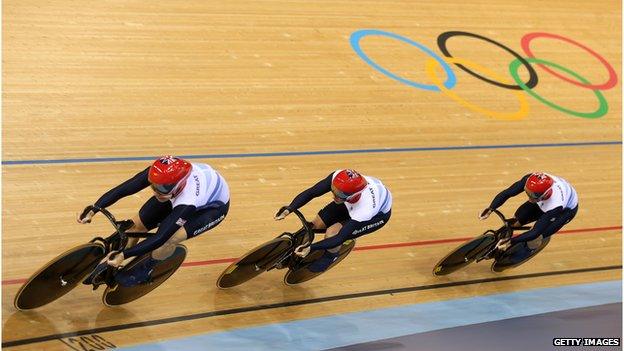
Team GB has had an amazing week of cycling success, but what is the science that lies behind the distinctive tactics on track and road?
For the laymen, cycling, and track cycling in particular, can be a little baffling.
Why in Victoria Pendleton's second race with Anna Meares did the competitors start off so slowly? Why did they almost stop at the top of the velodrome track?
Why does the person behind in a sprint so often win? Why does the lead cyclist in a team event drop off and rejoin at the back?
The answers provide fans with a practical lesson in physics.
Drafting or the importance of slipstreams
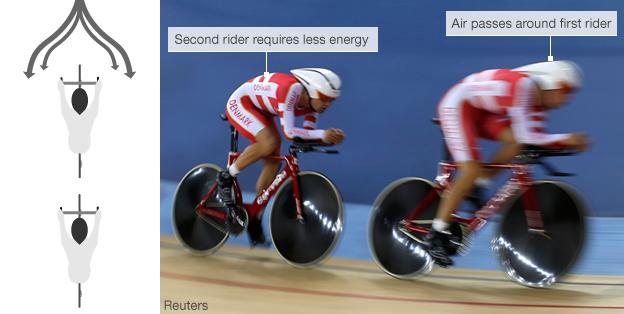
The science of the slipstream explains some of the cycling tactics that seem oddest to the layman.
The biggest enemy for the cyclist is wind resistance, says Chris Sidwells, author of the Official Tour de France Records book. One way to get round this is to use another rider's slipstream, known as "drafting". This is created by a cyclist's drag.
"Anybody who has ever been inside a house knows that solid objects like brick walls offer shelter from the wind," says Dutch novelist and cycling fan Tim Krabbe, author of The Rider. "The same principle applies to persons on bikes - people riding behind are sheltered, although not as much as by brick walls."
So how much are they sheltered?
The rider at the front uses about a third more energy than those behind, says Sidwells.
You have to be tucked in closely to the rider in front to gain this protection - the closer the better.
"You're talking about an inch or two in the Tour," says physicist Dr Lisa Jardine-Wright of Cavendish Laboratory, Cambridge University. "That's why there are so many pile-ups."
More than the length of a bicycle and the benefit of slipstream disappears in road racing.
Chris Boardman, head of research and development at Team GB, says that on the track, you can get even closer because there are no cross-winds. "They'll often touch in the team pursuit, that's how close they are. If you're millimetres behind - what we practise for in Team GB - then it's like sheltering behind a wall."
Without knowing a rider's body position and speed, it's hard to give an exact figure on what slipstream they'll create, says Prof Michael Leschziner, professor of computational aerodynamics at Imperial College London. It's such a complex area of physics that it requires each athlete to be tested in a wind tunnel before one can precisely quantify the slipstream.
If you think about the slipstream as a pocket of air, there is a rough formula for the size created by a moving disc, Leschziner says. It is about three times the diameter of the disc. So if a disc is one metre wide, the air pocket behind would be three metres long.
However, cyclists are not disc-shaped. The riding position, clothing and bike are all designed to create the minimum of wind resistance. The main drag is created by the cyclist's body.
It means the air pocket behind will be considerably shorter than three times the width of the cyclist's body. This explains why the cyclists need to get so close.
Why does the velodrome look like a Pringle?
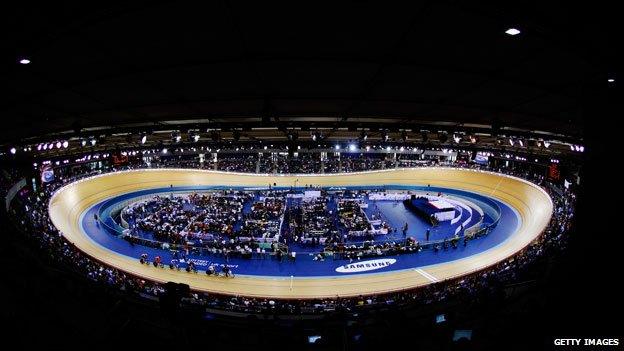
The velodrome track is a distinctive, oval shape. The reason for this is centripetal force. If a cyclist were to accelerate around a flat circular track, they would find it hard to stay on the track. Eventually they would reach a speed at which they would find it impossible to turn the corner and stay on the track. The banking on a velodrome allows riders to stay on by creating a centripetal force - one that pushes the rider inwards.
This is important as cyclists in the lead aim to travel the shortest distance possible, which means taking a racing line along the inside.
Engineering & Technology magazine has explained the track design, external. Dave Cockram, National Facilities Officer for British Cycling, told the magazine that velodrome tracks have changed over the years from two long flat straights with two banked circular turns to something more complex.
The modern velodrome now has "short straights with slopes of 10 degrees or more, transition curves with steadily increasing banking angles", circular curves with banking angles of around 45 degrees and transitions back into the straights.
More aerodynamics
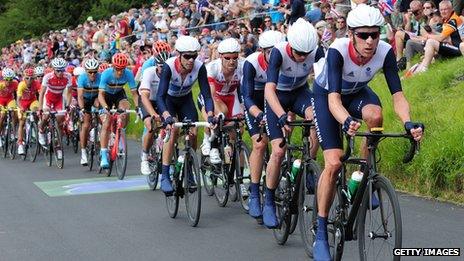
Air resistance is the bane of a cyclist's life. What determines resistance is the size of the object and the speed at which it's travelling.
At the kind of speeds cyclists are going, resistance (force exerted on cyclist) is proportional to the velocity squared, says Jardine-Wright. So for every doubling in speed, the resistance goes up by a factor of four.
The power required from the cyclist goes up by an even greater margin as speed increases. This is because power (force x speed) is related to velocity cubed, Jardine-Wright says. So for every doubling of speed, the cyclist is required to put in eight times more effort.
Coaches work with the riders in a wind tunnel to create the most streamlined body position, Boardman says. "The smaller you can make your silhouette, the better. There's a trade-off because you can lose muscle efficiency when you make yourself small. The rider has to choose the right balance."
Aerodynamics becomes ever more important when the need for manoeuvrability - useful in road races - reduces.
In time trial events, cyclists race against the clock rather than each other. There is no slipstream to shelter in.
It explains why the bikes are different. The back wheel is solid rather than spoked, and the handlebars go straight out rather than to the side to create as little wind resistance as possible. The reason the front wheel is still spoked is that the steering would be too slow if it was also solid.
In both the time trial and velodrome events, there is less need to worry about moving your head, says Matt Seaton, author of cycling memoir the Escape Artist. It explains the tear drop-shaped helmets with their long tails and reduced venting.
Having a minimum of air vents is a good way to maximise aerodynamic efficiency. These helmets would be far too hot, would restrict head motion and offer little protection in the Tour de France, Seaton says. But they offer the most aerodynamic shape for the rider in the velodrome.
Fast twitch v slow twitch muscles
The difference between sprinters and endurance cyclists is a good lesson on types of muscle. The muscle in your body that you can control is essentially divided up into two categories - slow and fast twitch.
The sprinters are bulkier and have more of the fast twitch muscle associated with explosive power. The endurance riders have thinner bodies with more slow twitch muscle, designed for stamina rather than sudden acceleration.
Chris Hoy and Cavendish are both sprinters, but the former specialises on the track, while the latter turns on the speed at the end of a road race. Bradley Wiggins, by contrast, is all about the long haul. So who would win over different distances?
"Over a kilometre or two, Hoy would win," says Sidwells. "Over 4km, Wiggins would win. But if Mark (Cavendish) could sit behind Bradley on the 4km, he would come past at the end."
Marginal gains
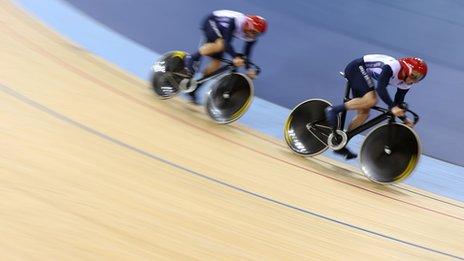
"Marginal gains" has become the mantra of British cycling in recent years. Team GB is always on the lookout for ways to improve.
Some are fairly big changes, such as the introduction of carbon fibre bikes. Others are more minute, such as the idea of spraying alcohol on the wheels to remove dirt and improve stickiness to the track, external.
Then there is the clothing. Experiments discovered that cyclists were soaking up too much sweat, mainly in their shorts. Where possible, cyclists wear a one-piece to aid smooth air flows and seams are kept to a minimum to prevent "dirty air" getting trapped.
Even Bradley Wiggins' famous sideburns would have been factored in, Sidwells guesses. "I bet Dave Brailsford reshaped Bradley's helmet to cope with the sideburns."
There is debate about how many tenths of a second some of these innovations shave off a rider's time. But they also have the added benefit of psyching out the opposition. The French team's anguished response to Team GB's success, wondering aloud about, external "magic wheels", is a case in point.
Boardman is unimpressed by the French comments. "These are the same wheels we used in Athens; some are literally the same ones. But no-one seems to have noticed. You can even go to UK Sport's website where they're on sale."